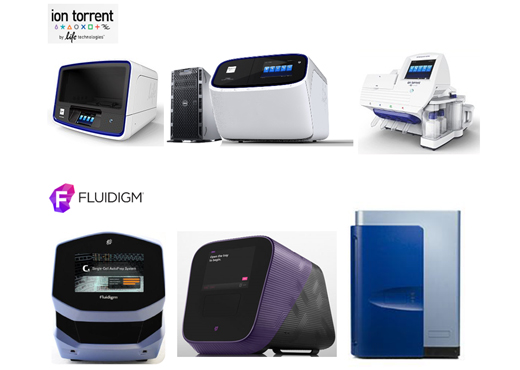服务项目
深度测序平台

Ion Torrent二代测序系统
一、国内外研究应用进展
以高通量、低成本为特征的的第二代测序(next-generation sequencing, NGS)技术发展迅速,当前风靡测序市场的该类主要产品分别隶属于Illumina和Life Technologies公司。我们研究所已购置的NGS测序平台为Life公司旗下的Ion Torrent测序平台。Ion Torrent是基于半导体芯片的新一代测序技术,比其他台式二代测序技术要更简单、更快速、性价比更高、通量灵活性更高。主要是使用一种布满小孔的高密度半导体芯片,一个小孔就是一个测序反应池。当DNA 聚合酶把核苷酸聚合到延伸中的DNA链上时会释放出一个H+,反应池中的pH 值发生变化,位于池下的离子感受器感受到此信号,把化学信号直接转化为数字信号,从而读出DNA 序列。
Ion Torrent 的技术特点包括:1、速度快:1-2天完成所有流程,快速出结果;2、灵活性高:兼顾少量样本和大量样本的不同运行需求;3、原理先进,为首款后光学测序平台;4、实验和结果分析流程高度自动化;5、唯一同时满足长读长和高通量的平台。
目前国内外Ion Torrent测序系统的医学相关应用主要集中在:1、病原微生物检测,包括微生物群落鉴定、微生物变异体鉴定、微生物耐药性检测。相对于传统的培养分离法,依赖测序技术的宏基因组分析能十分精确地揭示微生物种类和遗传的多样性,为微生物群落结构分析提供直观而全面的信息,对了解和监测治疗由多种微生物引起的感染性疾病有重要意义。而随着自然选择作用和生物体的不断进化,越来越多的微生物变异体悄然出现,当这些新的变异体引发的感染性疾病肆虐时,人们往往措手不及。因此,如何快速鉴定这些新的变异体有重要意义。Ion Torrent PGM快速明确了引发德国2011年肠出血性大肠杆菌(EHEC)暴发疫情的病原体及其进化关系和耐药基因,对遏制疫情起到了重要作用。而对已知的微生物耐药基因进行测序,能够更直观、准确、细致地在分子水平显示耐药基因的变异,对科研开发和临床用药有重要的指导意义。2、肿瘤检测。随着转化医学的发展,大量具有临床意义的肿瘤相关基因将会被发现,因此,大范围地进行基因检测也是肿瘤防治的有效手段。Ion Torrent创建了Ion AmpliSeq肿瘤测序平台,将肿瘤研究转化为一管式分析,能产生最多480个扩增子,覆盖46个肿瘤基因的相关区域,让低频突变能够得到准确经济的检测。随着Ion Torrent测序平台的进一步扩大,例如乳腺癌高危家族中属于抑制基因的BRCA基因突变的检测费用很有可能降低到200 美元以下,使Ion Torrent 技术能够更广泛地应用于临床重要基因突变的筛查。3、遗传病的检测。异常的有遗传性的家族性疾病或者由地域环境引起的高发病甚至某类人群的高发疾病都可通过高通量的NGS技术实现对其全基因组信息的读取而探究发病的遗传基础,从而指导临床治疗方案的选择。此外,在当前生殖医学高速发展的今天,尤其在试管婴儿大量出生的时代背景下,如何做好优质胚胎的选择,即胚胎植入前的基因鉴别的任务就依靠于NGS的优势发挥,结合了当前发展较为成熟的单细胞测序技术,可以从基因组学上实现很好的胚胎选择。Ion Torrent PGM 针对遗传病设计了AmpliSeq遗传病测序平台,3 个反应池包含超过10 000 对引物,可以扩增与700多种遗传病相关的328种基因的外显子,包括神经肌肉类、心脑血管类、生长发育类和遗传代谢类疾病。4、其他应用。除了普通的基因序列的读取辨别外,NGS也可对一系列的RNA进行测序,建立某些表达谱,还可以根据RNA序列反向验证某些基因编码序列的遗传背景。此外,对于那些基于大范围DNA甲基化所产生的环境相关疾病,更适合采用NGS技术进行DNA甲基化的测序工作,以此解释某些疾病发生的深层机制。
二、该平台在研究所的作用和意义
北京市肝病研究所,为一所市属公益性科研院所,旨在进一步拓宽肝病的研究领域,加快肝病防治工作的进程,减少肝脏疾病的发生,利用佑安医院的特色病种,将临床治疗与基础研究紧密结合起来,创建一支创新、发展的科研团队。HBV-慢性肝炎-肝癌是至今原因不明,是遗传、免疫背景很强的疾病。研究HBV感染者个体化转归差异的分子免疫学和肝细胞分子网络差异改变,寻求肝硬化和肝癌发生的分子机制对于防控肝癌的发生,降低肝癌发病率和死亡率都具有重要的意义。
在基因组测序技术快速进步以及生物信息与大数据科学的交叉应用的大环境下,精准医疗应运而生。精准医疗时代下的高通量基因测序发展正酣,尤其在遗传性出生缺陷的诊断和预防,肿瘤发生、发展与治疗的分子机制,各类重大遗传病的遗传分析等领域,尚有无限广阔的空间有待临床医务工作者和科研人员配合开拓。
在我国每年近28 万人死于肝硬化、肝癌等肝脏相关疾病,中国新发和死亡肝癌患者数量占全球一半以上,其中多数是因病毒性肝炎而致。能够为癌症患者提供准确的基因分析,给临床医生提供靶向药物和临床试验信息,最后给出最精确的个体化治疗方案是每个医学工作者的梦想。研究所Ion Torrent二代测序系统平台的建立可以实现综合分析全基因组、全转录组数据,发现肝炎、肝硬化和肝癌相关基因组、转录组水平相关信息,检测不同类型患者的转录水平和基因突变差异,同时也为人才梯队建设和学科骨干人才的培养,创造了条件。测序技术的高度发展会使全基因组序列读取更加便利和经济,个体化临床应用也会随之更加广阔和深入,由此将实现一个生命科学与医疗诊治交互作用的全新前景,从而实现肝脏病的精准医疗。
三、诊断和科研用途
(一)分子诊断
1、肿瘤个体化分子诊断
1.1 EGFR-TKIs药物与EGFR基因突变
1.2 克唑替尼与ALK基因突变
1.3 靶向药物与KRAS基因突变
1.4 靶向药物与BRAF基因突变
1.5 胃肠道间质瘤及格列卫药物与C-KIT基因、PDGFRA基因
1.6 P53基因突变与肿瘤
1.7 骨髓增殖性疾病与JAK2基因突变
1.8 家族性乳腺/卵巢癌与BRCA1/2基因突变
2、药物代谢相关分子诊断
2.1 伊立替康与UGT1A1基因多态性
2.2 华法林药物与CYP2C9、VKORC1和CYP4F2基因分型
3、遗传病分子诊断
3.1遗传性心律失常疾病
3.2单基因遗传病系列:地中海贫血、遗传性耳聋、苯丙酮尿症、血友病
4、血液系统疾病分子诊断
4.1 HLA高分辨率基因分型
4.2 白血病
5、妇婴生育保健分子诊断:主要为无创产前DNA检测(NIPT)
6、感染性疾病分子诊断
6.1感染性疾病基因分型:微生物16S rRNA鉴定
6.2 药物耐药相关基因:乙型肝炎病毒耐药基因突变
(二)科研用途
1、靶向测序:
相对于全基因组测序,靶向测序是一种快速、高性价比方法。Ion AmpliSeq™ 技术对这一应用进行了转化,使得研究人员可使用仅仅10 ng DNA即可快速简单地对数千靶标进行扩增。
2、转录组测序:
转录组测序,也称为RNA测序(RNA-Seq),可提供有关基因组组织和调控方式的基础信息。RNA测序依赖于二代测序 (NGS) 方法和技术。
3、异倍性及CNV分析:
拷贝数变异(CNV)分析是一种可用于异倍性等染色体畸变分析的二代测序方法。Ion PGM™系统二代测序提供了一种简单、快速的技术,能够可靠地获得易分析的数据。
4、小RNA及miRNA测序:
结合尖端的Ambion® RNA技术与易用的Ion Torrent™二代测序方法,任意实验室均可使用小RNA测序来了解发现更多信息。
5、病毒基因分型:
Ion PGM™系统结合PathAmp™ FluA试剂及用于Torrent Suite™软件的病原体分析插件,可以使研究人员在不到一天内完成甲型流感分型,获得的高精度序列数据,从而对流感追溯研究样品进行更有效的分析。
6、外显子组测序:
外显子组测序是一种靶向测序方法,可对基因组上与疾病发生相关的外显子组区域进行特异性研究。Life Technologies为提供了灵活、简单、价格实惠的Ion Proton™系统外显子组测序方案。
7、微生物测序:
随着Ion PGM™ 系统的通量越来越高、精确度越来越准确、读段越来越长,其逐渐被用来对特定疾病类型的追溯样品进行分析、监测,研究其发作方式,并进一步确定其病原学信息。
8、测序法基因分型:
人的基因组遗传变异存在多种形式,从较大的、完整结构的染色体变化到单核酸多态性(SNPs)都属于这种变异类型。Life Technologies™提供了一系列产品来对遗传变异及基因组表达谱进行分析。
9、从头测序:
Ion Torrent™半导体测序技术为微生物研究提供了革命性的从头测序方法,是一套可在一天内给出精确结果的简单、低成本系统。
10、细菌基因分型:
Ion PGM™系统可对成百上千的基因进行分型研究,快速、经济地给出全基因组序列信息,从而对于单一菌株获得更高的分辨能力和更精确的分型信息。
四、最近几年发表的与此相关的文章
1、Ion circulating tumor cells (CTCs) and cell-free DNA (cfDNA) Publications:
[1]Kelley RK, Magbanua MJ, Butler TM, et al. Circulating tumor cells in hepatocellular carcinoma: a pilot study of detection, enumeration, and next-generation sequencing in cases and controls. BMC Cancer. 2015;15: 206.
[2]Frenel JS, Carreira S, Goodall J, et al. Serial Next Generation Sequencing of Circulating Cell Free DNA Evaluating Tumour Clone Response To Molecularly Targeted Drug Administration. Clinical Cancer Research. 2015.
[3]Rothe F, Laes JF, Lambrechts D, et al. Plasma circulating tumor DNA as an alternative to metastatic biopsies for mutational analysis in breast cancer. Annals of Oncology. 2014;25: 1959-65.
[4]Couraud S, Vaca-Paniagua F, Villar S, et al. Noninvasive diagnosis of actionable mutations by deep sequencing of circulating free DNA in lung cancer from never-smokers: a proof-of-concept study from BioCAST/IFCT-1002. Clinical Cancer Research. 2014;20: 4613-24.
[5]Carreira S, Romanel A, Goodall J, et al. Tumor clone dynamics in lethal prostate cancer. Science Translational Medicine. 2014;6: 125r-254r.
[6]Kukita Y, Uchida J, Oba S, et al. Quantitative identification of mutant alleles derived from lung cancer in plasma cell-free DNA via anomaly detection using deep sequencing data. PLoS One. 2013;8: e81468.2、Ion Exome Sequencing Publications
2、Ion Exome Sequencing Publications:
[1]Oliveira J, Negrao L, Fineza I, et al. New splicing mutation in the choline kinase beta (CHKB) gene causing a muscular dystrophy detected by whole-exome sequencing.Journal of Human Genetics. 2015;60: 305-12.
[2]Wakil SM, Monies DM, Abouelhoda M, et al. Association of a mutation in LACC1 with a monogenic form of systemic juvenile idiopathic arthritis. Arthritis Rheumatol. 2015;67: 288-95.
[3]Severson PL, Vrba L, Stampfer MR, Futscher BW.Exome-wide mutation profile in benzo[a]pyrene-derived post-stasis and immortal human mammary epithelial cells.Mutat Res Genet Toxicol Environ Mutagen. 2014;775-776: 48-54.
[4]Monies DM, Al-Hindi HN, Al-Muhaizea MA, et al. Clinical and pathological heterogeneity of a congenital disorder of glycosylation manifesting as a myasthenic/myopathic syndrome. NeuromusculDisord. 2014;24: 353-59.
[5]Motoike IN, Matsumoto M, Danjoh I, et al. Validation of multiple single nucleotide variation calls by additional exome analysis with a semiconductor sequencer to supplement data of whole-genome sequencing of a human population. BMC Genomics. 2014;15: 673.
[6]Boland JF, Chung CC, Roberson D, et al. The new sequencer on the block: comparison of Life Technology's Proton sequencer to an IlluminaHiSeq for whole-exome sequencing. Human Genetics. 2013;132: 1153-63.
[7]Chong IY, Cunningham D, Barber LJ, et al. The genomic landscape of oesophagogastricjunctional adenocarcinoma.Journal of Pathology. 2013;231: 301-10.
3、Ion RNA-seq Publications:
[1]Narayan A, Bommakanti A, Patel AA. High-throughput RNA profiling via up-front sample parallelization. Nature Methods. 2015;12: 343-46.
[2]Smyth LJ, McKay GJ, Maxwell AP, McKnight AJ. DNA hypermethylation and DNA hypomethylation is present at different loci in chronic kidney disease. Epigenetics. 2014;9: 366-76.
[3]Thanh NM, Jung H, Lyons RE, et al. A transcriptomic analysis of striped catfish (Pangasianodonhypophthalmus) in response to salinity adaptation: De novo assembly, gene annotation and marker discovery. Comp BiochemPhysiol Part D Genomics Proteomics. 2014;10: 52-63.
[4]Cheng L, Sharples RA, Scicluna BJ, Hill AF. Exosomes provide a protective and enriched source of miRNA for biomarker profiling compared to intracellular and cell-free blood. J Extracell Vesicles. 2014;3.
[5]Nozawa M, Fukuda N, Ikeo K, Gojobori T. Tissue- and stage-dependent dosage compensation on the neo-X chromosome in Drosophila pseudoobscura. Molecular Biology and Evolution. 2014;31: 614-24.
[6]Li S, Tighe SW, Nicolet CM, et al. Multi-platform assessment of transcriptome profiling using RNA-seq in the ABRF next-generation sequencing study. Nature Biotechnology. 2014;32: 915-25.
4、Ion Targeted RNA Sequencing Publications:
[1]Lenz N, Schindler T, Kagina BM, et al. Antiviral Innate Immune Activation in HIV-Infected Adults Negatively Affects H1/IC31-Induced Vaccine-Specific Memory CD4+ T Cells. Clinical and Vaccine Immunology. 2015;22: 688-96.
[2]Poole A, Urbanek C, Eng C, et al. Dissecting childhood asthma with nasal transcriptomics distinguishes subphenotypes of disease. J Allergy ClinImmunol. 2014;133: 670-78.
5、Ion Viral Sequencing Publications:
[1]Yi X, Zou J, Xu J, et al. Development and validation of a new HPV genotyping assay based on next-generation sequencing. American Journal of Clinical Pathology. 2014;141: 796-804.
[2]Briese T, Mishra N, Jain K, et al. Middle East respiratory syndrome coronavirus quasispecies that include homologues of human isolates revealed through whole-genome analysis and virus cultured from dromedary camels in Saudi Arabia. MBio. 2014;5: e1114-46.
[3]Gibson RM, Meyer AM, Winner D, et al. Sensitive deep-sequencing-based HIV-1 genotyping assay to simultaneously determine susceptibility to protease, reverse transcriptase, integrase, and maturation inhibitors, as well as HIV-1 coreceptor tropism. Antimicrob Agents Chemother. 2014;58: 2167-85.
6、Ion Targeted DNA Sequencing Publications:
[1]Hovelson DH, McDaniel AS, Cani AK, et al. Development and validation of a scalable next-generation sequencing system for assessing relevant somatic variants in solid tumors. Neoplasia. 2015;17: 385-99.
[2]Wang T, Zhan X, Bu CH, et al. Real-time resolution of point mutations that cause phenovariance in mice. ProcNatlAcadSci U S A. 2015;112: E440-49.
[3]Warrick JI, Hovelson DH, Amin A, et al. Tumor evolution and progression in multifocal and paired non-invasive/invasive urothelial carcinoma. VirchowsArchiv. 2015;466: 297-311.
[4]Baquero-Montoya C, Gil-Rodriguez MC, Braunholz D, et al. Somatic mosaicism in a Cornelia de Lange syndrome patient with NIPBL mutation identified by different next generation sequencing approaches. Clinical Genetics. 2014;86: 595-97.
[5]Beck J, Pittman A, Adamson G, et al. Validation of next-generation sequencing technologies in genetic diagnosis of dementia. Neurobiology of Aging. 2014;35: 261-65.
[6]Bell CC, Magor GW, Gillinder KR, Perkins AC. A high-throughput screening strategy for detecting CRISPR-Cas9 induced mutations using next-generation sequencing. BMC Genomics. 2014;15: 1002.
[7]Ezgu F, Ciftci B, Topcu B, et al. Diagnosis of glycine encephalopathy in a pediatric patient by detection of a GLDC mutation during initial next generation DNA sequencing. Metabolic Brain Disease. 2014;29: 211-13.
[8]Niba ET, Tran VK, Tuan-Pham LA, et al. Validation of ambiguous MLPA results by targeted next-generation sequencing discloses a nonsense mutation in the DMD gene. ClinicaChimicaActa. 2014;436: 155-59.
[9]Rechsteiner M, Muller R, Reineke T, et al. Modelling of a genetically diverse evolution of Systemic Mastocytosis with Chronic Myelomonocytic Leukemia (SM-CMML) by Next Generation Sequencing. ExpHematolOncol. 2014;3: 18.
[10]Woyach JA, Furman RR, Liu TM, et al. Resistance mechanisms for the Bruton's tyrosine kinase inhibitor ibrutinib. N Engl J Med. 2014;370: 2286-94.
[11]Kukita Y, Uchida J, Oba S, et al. Quantitative identification of mutant alleles derived from lung cancer in plasma cell-free DNA via anomaly detection using deep sequencing data. PLoS One. 2013;8: e81468.
7、Ion Metagenomic Publications:
[1]Mondav R, Woodcroft BJ, Kim EH, et al. Discovery of a novel methanogen prevalent in thawing permafrost. Nature Communications. 2014;5: 3212.
[2]Ly M, Abeles SR, Boehm TK, et al. Altered oral viral ecology in association with periodontal disease. MBio. 2014;5: e1114-33.
8、Ion Genotyping by Sequencing Publications:
[1]Mascher M, Wu S, Amand PS, Stein N, Poland J. Application of genotyping-by-sequencing on semiconductor sequencing platforms: a comparison of genetic and reference-based marker ordering in barley. PLoS One. 2013;8: e76925.
9、Ion Viral Typing Publications:
[1]Zhang Y, Mao H, Yan J, et al. Isolation and characterization of H7N9 avian influenza A virus from humans with respiratory diseases in Zhejiang, China. Virus Research. 2014;189: 158-64.
[2]Zhou B, Lin X, Wang W, et al. Universal influenza B virus genomic amplification facilitates sequencing, diagnostics, and reverse genetics. Journal of Clinical Microbiology. 2014;52: 1330-37.
10、Ion NIPT and Aneuploidy Detection Publications:
[1]Liao C, Yin AH, Peng CF, et al. Noninvasive prenatal diagnosis of common aneuploidies by semiconductor sequencing. ProcNatlAcadSci U S A. 2014;111: 7415-20.
五、研究所可提供的临床和科研服务项目
(一)临床服务项目
1、肿瘤个体化分子诊断:主要为肝癌相关
2、妇婴生育保健分子诊断:针对佑安医院产科,可进行无创产前DNA检测(NIPT)
3、感染性疾病分子诊断:如HBV/HIV药物耐药相关基因突变检测
(二)科研用途
1、靶向测序
2、转录组测序
3、外显子组测序
4、微生物测序
5、从头测序
Fluidigm单细胞自动制备及单细胞测序表达谱系统
一、国内外研究应用进展
单细胞测序技术可谓是科技发展史上的一大创举。细胞是生物学的基本单位,研究人员正努力尝试将它们进行单个分离、研究和比较。一个细胞里的DNA或RNA仅仅处在皮克(picograms)级的水平,如此少的量远远达不到现有测序仪的最低上样需求。目前生物学研究中的基因组测序多是提取大量细胞中的遗传物质后进行的,忽略了细胞间的差异,而单细胞测序可以避免这种情况。因此科学家们必须先对单细胞内的微量核酸分子进行扩增,而且必须保证尽可能少地出现技术误差,以便开展后续的测序及其他研究。一些科学家认为,通过研究单个、完整细胞内的遗传物质,有朝一日可以理解细胞特别是脑细胞的工作机制。而了解癌细胞如何在肿瘤内变化以及每个细胞内“定居”着多少版本的基因,相关技术有望用于癌症诊断。
Fluidigm微流体系统通过将巨量的流体元件集成于单一微流体芯片,克服了诸多传统实验室系统的局限性。Fluidigm技术使其客户在利用微量试剂和样品的同时,能够采用小于一个细胞容量的样品执行和测量数以千计的尖端复杂生物化学反应。同样,对于下一代 DNA测序,Fluidigm系统能够以较低的成本迅速准备多个样本。Fluidigm单细胞自动制备及单细胞测序表达谱系统由C1™系统、Juno™系统和BioMark™ HD系统组成。C1单细胞全自动制备系统是全世界最先推出的全自动单细胞分离和制备系统。C1系统为每次运行处理96个单细胞提供了简单轻松、高度重复的流程,而手工操作所需的时间极少。它前所未有地让分离细胞、提取、逆转录和扩增过程实现全面自动化,使细胞活性的检测和分析成为可能,并减少了多平台技术错误所引起的可变性。Juno系统为全新SNP基因分型平台,在不到3小时的时间内处理并完成低至2.5ng/ul的DNA样本的SNP基因分型(如组织,口腔拭子,血,石蜡包埋组织和多倍体生物),有效突破了基因分型领域目前对高浓度、高质量DNA要求的瓶颈。BioMark™ HD高通量基因分析系统是集成流体通路(Integrated Fluidic Circuit,IFC)技术、实时定量PCR技术及强大的基因分析软件相结合的技术平台。BioMark HD系统由BioMark™实时PCR系统(整合了高性能计算机)、IFC微液流芯片(耗材)、IFC Controller(将生物样品、反应试剂导入到IFC微液流芯片中)和基因分析软件四部分构成。IFC微液流芯片有2种:Dynamic Array(48.48动态芯片和96.96动态芯片)和Digital Array(12.765数码芯片和48.770数码芯片),应用于不同的基因分析中:拷贝数变化分析、遗传突变检测、基因分型、基因定量、单细胞基因表达等。
单细胞研究的核心问题其实是:为什么要进行单细胞研究?这主要是因为如果将成千上万个细胞混在一起进行研究,就会模糊我们对大脑、血液系统、免疫系统,及其组成这些系统的细胞之间异质性(heterogeneity)的认识。当研究深入到单细胞层面时,就可能会失去对整个系统的把控,但是如果能够从整个系统中挑选多个不同的单细胞进行研究,则可以重建出整个系统,而且这种重建过程能够提供更多更有价值的信息。比较罕见的细胞、异质性的样本、与遗传嵌合或突变相关的表型、不能人工培养的微生物,这些都是单细胞测序技术能够一展所长的研究平台。使用单细胞测序技术能够发现克隆突变(clonal mutation)、隐藏的细胞类型,或者在大块组织样品研究工作中被“稀释”或平均掉的转录特征。目前单细胞研究主要集中在遗传学、神经科学、肿瘤及微生物生态学等领域,如单细胞生物的单细胞测序、人类单体型(human haplotypes)研究、体细胞突变研究等。对单细胞的基因表达情况进行检测和分析非常有助于我们了解细胞的行为,以及明确都有哪些细胞参与了组织发育、成熟和病变的过程。单细胞RNA测序的实现使得步入一个单细胞转录组学时代,该研究方向会对生物学和医学产生深刻的影响。单细胞RNA测序技术尤其适用于对体内的肿瘤细胞进行分析,因为针对一堆转化细胞、间质细胞和其它浸润细胞单独提取转录产物进行分析,可以了解各种转录产物的丰度和亚型信息。对离散的肿瘤组织和健康组织进行单细胞转录组分析还可以精确地确定与转化状态相关的、不同的mRNA亚型。转录组上的差异也有助于我们认识肿瘤的进展情况,更好地认识CTC细胞的异质性问题,帮助大家更好地认识CTC细胞进入血液循环系统时的基因表达情况。技术上的新进展已经让单细胞基因组测序技术(single-cell genome sequencing)逐渐成为了一项主流的检测手段,该领域的研究工作已经初步揭示出细胞之间在基因组结构(genetic architecture)与遗传变异性(genetic variability)方面的差异,这也反映出基因组并非一成不变的天然本质。
通常,将具有同一表型的细胞看作是一个具有特定功能的整体,并将其称作组织或者器官。不过对单个细胞进行深度DNA和RNA测序会发现,各种各样的细胞状态构成了一个复杂的生态系统,这样一个复杂的系统才形成了组织和器官的整体功能。继续发展高信息度、实时的、多模单细胞检测技术将有助于真正认识处于微环境系统下单个细胞的功能。对单细胞的DNA和RNA进行深度测序就能够以前所未有的更高的分辨率,更全面地掌握细胞的功能。对细胞状态的这种特异性识别能力有助于我们更好地了解细胞的正常功能和异常情况。
二、该平台在研究所的作用和意义
北京市肝病研究所,为一所市属公益性科研院所,旨在进一步拓宽肝病的研究领域,加快肝病防治工作的进程,减少肝脏疾病的发生,利用佑安医院的特色病种,将临床治疗与基础研究紧密结合起来,创建一支创新、发展的科研团队。HBV-慢性肝炎-肝癌是至今原因不明,是遗传、免疫背景很强的疾病。研究HBV感染者个体化转归差异的分子免疫学和肝细胞分子网络差异改变,寻求肝硬化和肝癌发生的分子机制对于防控肝癌的发生,降低肝癌发病率和死亡率都具有重要的意义。
2013年,单细胞测序技术(single-cell sequencing)荣膺《自然-方法》年度技术。单细胞测序技术有助于剖析细胞的异质性。它可以揭示肿瘤细胞基因组中发生的突变及结构性变异,而这些突变和变异往往有着极高的突变率。有了这些信息,就可以描述肿瘤细胞的克隆结构,并追踪疾病的进展及扩散范围。
在我国每年近28 万人死于肝硬化、肝癌等肝脏相关疾病,中国新发和死亡肝癌患者数量占全球一半以上,其中多数是因病毒性肝炎而致。研究所Fluidigm单细胞自动制备及单细胞测序表达谱系统的建立可以实现单细胞制备分离、单细胞基因组及转录组测序。高通量的病变组织单细胞分析能够同时检测细胞的组成变化(通过细胞聚类分析手段)和相应的基因表达变化。我们可以对健康组织和病变组织里特定的细胞进行比较,发现与疾病相关的特异性基因表达改变情况。对肝癌患者单个CTC细胞进行转录组学分析是一种无创检测手段,可帮助临床医生们选择合适的抗癌药物和治疗方案,随时监测病情的进展情况和疗效,还可以根据 CTC细胞上的分子标志物确定将来的靶向治疗方案。我们可以以新的视角看待HBV-慢性肝炎-肝癌的发生机制。
三、诊断和科研用途
1、单细胞全基因组测序
基于单个细胞水平上采取高质量的全基因组扩增与测序相结合的一项新技术,该技术目前主要应用于肿瘤发生机制及胚胎发育研究。由于肿瘤细胞之间具有异质性,采用该项技术不需培养细胞,可最真实的获得单克隆癌细胞的具体突变来源及精准的突变频率,以及区分癌症发生、发展、演化过程中的主动与被动突变等。
2、单细胞转录组测序
利用高质量的基因组扩增技术,对单个细胞水平上的mRNA进行测序分析的技术。该技术可以从单细胞水平解释基因表达异常及RNA编辑现象在癌症的发生、发展、演化过程中的作用。
3、Single-cell targeted gene expression
4、Single-cell MicroRNA
四、最近几年发表的与此相关的文章
1、Analysis Methods Publications:
[1]Trapnell, C. et al. “The dynamics and regulators of cell fate decisions are revealed by pseudotemporal ordering of single cells.” NatureBiotechnology 32(4) (2014): 381–6.*
2、Cancer Research Publications:
[1]Benavides-Garcia, R. et al. “Granulocyte colony-stimulating factor prevents loss of spermatogenesis after sterilizing busulfanchemotherapy.” Fertility and sterility 103(1) (2014): 270–280.e8.*
[2]Gawad, C. et al. “Dissecting the clonal origins of childhood acute lymphoblastic leukemia by single-cell genomics.” Proceedings of theNational Academy of Sciences of the United States of America 111(50) (2014): 1,7947–52.*
[3]Azizi, E. et al. “The promise of single cell omics for onco-therapy.” Journal of molecular and genetic medicine: an international journal ofbiomedical research 8 (2014): 3.*
[4]Ennen, M. et al. “Single-cell gene expression signatures reveal melanoma cell heterogeneity.” Oncogene (2014): doi: 10.1038*
[5]Landau, D. et al. “Locally disordered methylation forms the basis of intratumormethylome variation in chronic lymphocyticleukemia.”Cancer Cell 26(6) (2014): 813–25.*
[6]Papaemmanuil, E. et al. “RAG-mediated recombination is the predominant driver ofoncogenic rearrangement in ETV6-RUNX1 acutelymphoblastic leukemia.” Nature Genetics 46(2) (2014): 116–25.
3、Cardiovascular Research Publications:
[1]Chini, V. et al. “Micro-RNAs and next generation sequencing: new perspectives in heart failure.” Clinicachimicaacta (2014):doi: 10.1016/j.cca.2014.11.020.*
[2]Fu, J. et al. “Direct reprogramming of human fibroblasts toward a cardiomyocyte-like state.” Stem Cell Reports 1(3) (2013): 235–47.*
4、Circulating Tumor Cells Publications:
[1]Ozkumur, E. et al. “Inertial focusing for tumor antigen– dependent and –independent sorting of rare circulating tumor cells.” ScienceTranslational Medicine 5(179) (2013): 179ra47.
[2]Powell, A.A. et al. “Single cell profiling of circulating tumor cells: transcriptional heterogeneity and diversity from breast cancer cell lines.”PLoS ONE 7 (2012): (5):e33788.
[3]Helzer, K.T. et al. “Circulating tumor cells are transcriptionally similar to the primary tumor in a murine prostate model.” Cancer Research69(19) (2009): 7,860–6.
5、Embryonic Stem Cells and DevelopmentPublications:
[1]Brunskill, E.W. et al. “Single cell dissection of early kidney development: multilineage priming.” Development 141(15) (2014): 3,093–101.*
[2]Behrens, A. et al. “Sox7 is regulated by Etv2 during cardiovascular development.” Stem Cells and Development 23(17) (2014): 2,004–13.*
[3]Duscher, D. et al. “Aging disrupts cell subpopulation dynamics and diminishes the function of mesenchymal stem cells.” ScientificReports 4 (2014): 7144.
[4]Turner, D.A. et al. “Wnt/β-catenin and FGF signalling direct the specification and maintenance of a neuromesodermal axial progenitor inensembles of mouse embryonic stem cells.” Development 141(22) (2014): 4,243–53.
[5]Li, N. et al. “Single-cell analysis of proxy reporter allele-marked epithelial cells establishes intestinal stem cell hierarchy.” Stem CellReports 3(5) (2014): 876–91.
6、Gene Expression ProfilingPublications:
[1]Dorrell, C. et al. “The organoid-initiating cells in mouse pancreas and liver are phenotypically and functionally similar.” Stem Cell Reports2 (2014): 275–83.
[2]Bennett, R. et a. “Laser microdissection of the alveolar duct enables single-cell genomic analysis.” Frontiers in Oncology 4 (2014): 260.*
[3]Shalek, A.K. et al. “Single-cell transcriptomics reveals bimodality in expression and splicing in immune cells.” Nature 498(7453) (2013):236–40.
[4]Buczacki, S.J. et al. “Intestinal label-retaining cells are secretory precursors expressing Lgr5.” Nature 495(7439) (2013): 65–9.
[5]McDavid, A. et al. “Data exploration, quality control and testing in single-cell qPCR-based gene expression experiments.” Bioinformatics29(4) (2013): 461–7.
7、Hematopoietic Stem Cells and ProgenitorsPublications:
[1]Grover, A. et al. “Erythropoietin guides multipotent hematopoietic progenitor cells toward an erythroid fate.” Journal of ExperimentalMedicine 211(2) (2014): 181–8.*
[2]Becher, B. et al. “High-dimensional analysis of the murine myeloid cell system.” Nature Immunology 12 (2014): 1,181–9.**
[3]Miyawaki, K. et al. “CD41 marks the initial myelo-erythroid lineage specification in adult mouse hematopoiesis: Redefinition of murinecommon myeloid progenitor.” Stem Cells (2014): doi: 10.1002/stem.1906.
8、Immunity/Infectious DiseasePublications:
[1]Wang, J. et al. “RNA-guided endonuclease provides a therapeutic strategy to cure latent herpesviridae infection.” Proceedings of theNational Academy of Sciences of the United States of America 111(36) (2014):13,157–62.*
[2]Shalek A.K. et al. “Single-Cell RNA-seq reveals dynamic paracrine control or cellular variation.” Nature 509(7,505) (2014): 363–9.*
[3]Mahata, B. et al. “Single-cell RNA sequencing reveals T helper cells synthesizing steriodsde novo to contribute to immunehomeostasis.” Cell Reports 7(4) (2014): 1,130–42.*
[4]Strauss-Albee, D.M. et al. “Coordinated regulation of NK receptor expression in the maturing human immune system.” Journal ofImmunology 193(10) (2014): 4,871–9.**
[5]Swadling, L. et al. “A human vaccine strategy based on chimpanzee adenoviral and MVA vectors that primes, boosts, and sustainsfunctional HCV-specific T cell memory.” Science Translational Medicine 6(261) (2014): 261ra153.**
9、Induced Pluripotent Stem Cells (IPS)Publications:
[1]Dominguez, A. et al. “Human germ cell formation in xenotransplants of induced pluripotent stem cells carrying X chromosomeaneuploidies.” Scientific Reports 4 (2014): 6,432.
[2]Chanda, S. et al. “Generation of Induced Neuronal Cells by the Single Reprogramming Factor ASCL1.” Stem Cell Reports 3(2) (2014):282–96.
[3]Burridge, P.W. et al. “Chemically defined generation of human cardiomyocytes.” Nature Methods 11(8) (2014): 855–60.
10、MASS CYTOMETRYPublications:
[1]Edgar, L.J. et al. “Identification of Hypoxic Cells Using an Organotellurium Tag Compatible with Mass Cytometry.” Science TranslationalMedicine 53(43) (2014): 11,473–7.**
[2]Giesen, C. et al. “Highly multiplexed imaging of tumor tissues with subcellular resolution by mass cytometry.” Nature Methods 4 (2014):417–22.**
[3]Leipold, M.D. et al. “Mass cytometry: protocol for daily tuning and running cell samples on a CyTOF mass cytometer.” Journal ofVisualized Experiments 69 (2012): e4398.**
11、Neural ResearchPublications:
[1]Romanov, R. et a. “A secretagogin locus of the mammalian hypothalamus controls stress hormone release.” The EMBO Journal 34(1)(2014): 36–54.*
[2]Victor, M. et al. “Generation of human striatal neurons by microRNA-dependent direct conversion of fibroblasts.” Neuron 84(2) (2014):311–23.
[3]Park, J. et al. “Identifying functional gene regulatory network phenotypes underlying single cell transcriptional variability.” Progress inbiophysics and molecular biology S0079–6107(14) (2014): 00183–7.
12、New MethodsPublications:
[1]Yao, Y. et al. “CyTOF supports efficient detection of immune cell subsets from small samples.” Journal of Immunological Methods 145(2014): 1–5.**
[2]Behbehani, G. et al. “Transient partial permeabilization with saponin enables cellular barcoding prior to surface marker staining.”Cytometry Part A 85(12) (2014): 1,011–9.**
[3]O’Neill, K. et al. “Enhanced flowType/RchyOptimyx: A bioconductor pipeline for discovery in high-dimensional cytometry data.”Bioinformatics 30(9) (2014): 1,329–30.**
[4]Amir el, A.D. et al. “viSNE enables visualization of high dimensional single-cell data and reveals phenotypic heterogeneity of leukemia.”Nature Biotechnology 31(6) (2013): 545–52.**
13、RNA SEQPublications:
[1]Tang, X. et al. “The eSNV-detect: a computational system to identify expressed single nucleotide variants from transcriptomesequencing data.” Nucleic Acids Research 42(22) (2014): e172.*
[2]Pollen, A.A. et al. “Low-coverage single-cell mRNA sequencing reveals cellular heterogeneity and activated signaling pathways indeveloping cerebral cortex.” Nature Biotechnology 32(10) (2014): 1,053–8.*
[3]Saliba A.E. et al. “Single-cell RNA-seq: advances and futurechallenges.” Nucleic Acids Research 42(14) (2014): 8,845–60.*
[4]Treutlein, B. et al. “Reconstructing lineage hierarchies of the distal lung epithelium using single-cell RNA-seq.” Nature 509(7,500) (2014):371–5.*
[5]Islam, S. et al. “Quantitative single-cell RNA-seq with unique molecular identifiers.” Nature Methods 11(2) (2013): 163–6.*
[6]Wu, A.R. et al. “Quantitative assessment of single-cell RNA-sequencing methods.” Nature Methods 11(1) (2013): 41–6.*
[7]Brennecke, P. et al. “Accounting for technical noise in single-cell RNA-Seq experiments.” Nature Methods 10(11) (2013): 1,093–5.*
五、研究所可提供的临床和科研服务项目
1、单细胞全基因组测序
2、单细胞转录组测序
3、Single-cell targeted gene expression
联系人:魏飞力、欧阳雅博
联系电话:010-63057109/010-83997424/010-83997425
电子邮箱:bjsgbyjs@qq.com









 京公网安备11010602050066号
京公网安备11010602050066号



